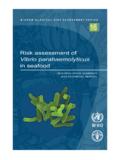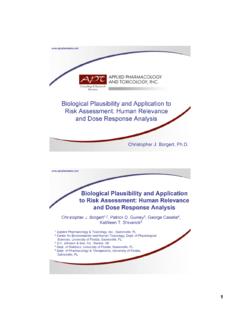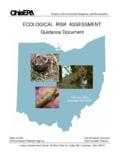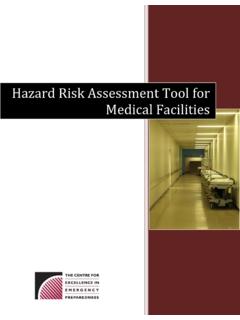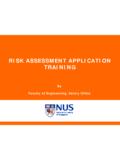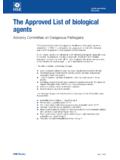Transcription of Section II—Biological Risk Assessment
1 biological Risk Assessment 9 Section II biological Risk AssessmentRisk Assessment is an important responsibility for directors and principal investigators of microbiological and biomedical laboratories. Institutional biosafety committees (IBC), animal care and use committees, biological safety professionals, and laboratory animal veterinarians share in this responsibility. Risk Assessment is a process used to identify the hazardous characteristics of a known infectious or potentially infectious agent or material, the activities that can result in a person s exposure to an agent, the likelihood that such exposure will cause a LAI, and the probable consequences of such an infection.
2 The information identified by risk Assessment will provide a guide for the selection of appropriate biosafety levels and microbiological practices, safety equipment, and facility safeguards that can prevent directors and principal investigators should use risk Assessment to alert their staffs to the hazards of working with infectious agents and to the need for developing proficiency in the use of selected safe practices and containment equipment. Successful control of hazards in the laboratory also protects persons not directly associated with the laboratory, such as other occupants of the same building, and the Assessment requires careful judgment.
3 Adverse consequences are more likely to occur if the risks are underestimated. By contrast, imposition of safeguards more rigorous than actually needed may result in additional expense and burden for the laboratory, with little safety enhancement. Unnecessary burden may result in circumvention of required safeguards. However, where there is insufficient information to make a clear determination of risk, it is prudent to consider the need for additional safeguards until more data are primary factors to consider in risk Assessment and selection of precautions fall into two broad categories: agent hazards and laboratory procedure hazards.
4 In addition, the capability of the laboratory staff to control hazards must be considered. This capability will depend on the training, technical proficiency, and good habits of all members of the laboratory, and the operational integrity of containment equipment and facility agent summary statements contained in BMBL identify the primary agent and procedure hazards for specific pathogens and recommend precautions for their control. The guest editors and contributors of this and previous editions of BMBL based their recommendations on an Assessment of the risks associated with the handling of pathogens using generally routine generic laboratory procedures.
5 A review of the summary statement for a specific pathogen is a helpful starting point for Assessment of the risks of working with that agent and those for a similar Biosafety in Microbiological and Biomedical LaboratoriesHazardous Characteristics of an AgentThe principal hazardous characteristics of an agent are: its capability to infect and cause disease in a susceptible human or animal host, its virulence as measured by the severity of disease, and the availability of preventive measures and effective treatments for the disease. The World Health Organization (WHO) has recommended an agent risk group classification for laboratory use that describes four general risk groups based on these principal characteristics and the route of transmission of the natural The four groups address the risk to both the laboratory worker and the community.
6 The NIH Guidelines established a comparable classification and assigned human etiological agents into four risk groups on the basis of The descriptions of the WHO and NIH risk group classifications are presented in Table 1. They correlate with but do not equate to biosafety levels. A risk Assessment will determine the degree of correlation between an agent s risk group classification and biosafety level. See Section 3 for a further discussion of the differences and relatedness of risk groups and biosafety 1: Classification of Infectious Microorganisms by Risk GroupRisk Group ClassificationNIH Guidelines for Research involving Recombinant DNA Molecules 20022 World Health Organization Laboratory Biosafety Manual 3rd Edition 20041 Risk Group 1 Agents not associated with disease in healthy adult humans.
7 (No or low individual and community risk) A microorganism unlikely to cause human or animal Group 2 Agents associated with human disease that is rarely serious and for which preventive or therapeutic interventions are often available.(Moderate individual risk; low community risk) A pathogen that can cause human or animal disease but is unlikely to be a serious hazard to laboratory workers, the community, livestock or the environment. Laboratory exposures may cause serious infection, but effective treatment and preventive measures are available and the risk of spread of infection is limited.
8 Risk Group 3 Agents associated with serious or lethal human disease for which preventive or therapeutic interventions may be available (high individual risk but low community risk).(High individual risk; low community risk) A pathogen that usually causes serious human or animal disease but does not ordinarily spread from one infected individual to another. Effective treatment and preventive measures are available. Risk Group 4 Agents likely to cause serious or lethal human disease for which preventive or therapeutic interventions are not usually available (high individual risk and high community risk).
9 (High individual and community risk)A pathogen that usually causes serious human or animal disease and can be readily transmitted from one individual to another, directly or indirectly. Effective treatment and preventive measures are not usually biological Risk Assessment 11 Other hazardous characteristics of an agent include probable routes of transmission of laboratory infection, infective dose, stability in the environment, host range, and its endemic nature. In addition, reports of LAIs are a clear indicator of hazard and often are sources of information helpful for identifying agent and procedural hazards, and the precautions for their control.
10 The absence of a report does not indicate minimal risk. Reports seldom provide incidence data, making comparative judgments on risks among agents difficult. The number of infections reported for a single agent may be an indication of the frequency of use as well as risk. Nevertheless, reporting of LAIs by laboratory directors in the scientific and medical literature is encouraged. Reviews of such reports and analyses of LAIs identified through extensive surveys are a valuable resource for risk Assessment and reinforcement of the biosafety principles. The summary statements in BMBL include specific references to reports on predominant probable routes of transmission in the laboratory are: 1) direct skin, eye or mucosal membrane exposure to an agent; 2) parenteral inoculation by a syringe needle or other contaminated sharp, or by bites from infected animals and arthropod vectors; 3) ingestion of liquid suspension of an infectious agent, or by contaminated hand to mouth exposure; and 4) inhalation of infectious aerosols.










